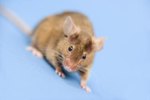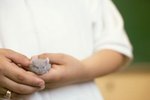The dwarf mouse most commonly kept as a pet is the African pygmy mouse (Mus minutoides), one of the tiniest rodents in the world. Adults grow to no more than about 1.5 inches long, excluding tail, and weigh less than half an ounce. Because they are so tiny and fragile, they are not suitable pets for children -- even older ones -- as the slightest mishandling could break their bones. Adults with some experience of rodent care are suited to caring for dwarf mice.
Housing
African pygmy mice might be small, but they don’t take well to small habitats, mainly because they are extremely active. Cages for dwarf hamsters might look suitable for these mice, but they tend to be too small and the mice may be able to wriggle through the bars. The best bet is a large glass or plastic tank with a wire mesh lid for ventilation. Capacity of 10 gallons is an absolute minimum; 20 gallons or more would be better.
Accessories
A thick layer of a paper-based substrate is essential. On top, provide plenty of places to hid and explore, either plain functional ones, such as cardboard tubes and boxes, or more aesthetically appealing ones, such as large pieces of nontoxic bark, hollow logs and wooden huts. You’ll also need shallow bowls for water and food. A solid wheel made for dwarf hamsters might be appreciated, but never use one with open rungs. Such wheels can break legs and snatch tails.
Companions
Because they are sociable little creatures, you should have at least three African pygmy mice. It goes without saying that they should be the same gender; otherwise you’ll end up with an awful lot more than three. Like all mice, this species breeds early and prolifically.
Diet
The diet of African pygmy mice is not very different from that of your standard pet mouse. In the wild, the species eats a varied diet of bugs, seeds and fruit; in captivity they need much the same. Suitable foods include a canary or parakeet seed mix supplemented with fresh produce and a little dog kibble. Live foods, such as mealworms, make an excellent occasional treat, but don’t give these mice insects bigger than they are.
Special Considerations
Males are more likely to fight; if you have a small group of males, it is crucial to provide the largest tank available with plenty of places for each mouse to retreat to. Don’t keep a mixed-sex group – even if you could find good homes for a few mice, you’ll still end up with far too many.
Other Dwarf Mice
A couple of varieties of Mus musculus -- the common domesticated mouse -- are smaller than normal, similar to toy versions of already small dog breeds. These mice have no special needs. Just care for them as you would any other pet mouse. Some other species of tiny mouse, including harvest mice, occasionally appear in the pet trade, and the needs of these critters vary widely, so research the species carefully.
References
Writer Bio
Judith Willson has been writing since 2009, specializing in environmental and scientific topics. She has written content for school websites and worked for a Glasgow newspaper. Willson has a Master of Arts in English from the University of Aberdeen, Scotland.




